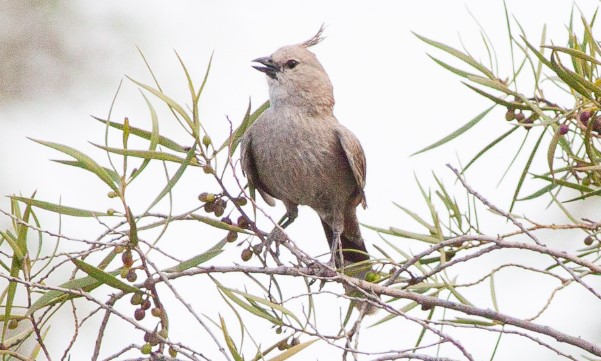Chirruping Wedgebill (Psophodes cristatus) is named for its short, tapered, finch-like bills.
This is the most communal of the whip birds. The Chirruping Wedgebill is 190–200 mm long. Adult birds establish small, sedentary colonies of 20 to 25 birds in pockets of taller but still broken shrubbery. This is in the rolling shrub steppes of the arid Darling and southeastern Lake Eyre basins. Thickets of spiny The Chirruping Wedgebill live in arid shrub steppes in eastern Australia. There is a preference for Acacia victoriae, niter bush Nitraria, and boxthorn Lycium, often with a limited area of about one hectare. This bird is often confused with chiming wedgebill, hence, its main identification is its faded breast streaking, somewhat longer tail, and recurring chirruping call
The Chirruping Wedgebill is a member of the genus Psophodes, and the family Psophodidae. Keeping covered, the birds run over the ground and climb into low branches foraging foraging for food, picking small insects and seeds. Flutters and short glides often characterize the flight from bush to bush. The tail is part-spread and the flight is low.

After breeding, brown-billed juveniles band together in loose foraging flocks of up to several hundred that wander widely across the countryside. In March-May and August-November, or after rains, nesting, and breeding occur. Nest in loose twigs, grass, and bark; lined with fine material; close to the ground and less than 3 meters high in a stout upright fork inside a dense shrub or tree.
The song of the Chirruping Wedgebill is like a continuous cycle of chirrup, wu-cheeeer, repeated over and over; all given by one bird or antiphonally, one bird singing the first soft note and another the succeeding loud descending trill. The territorial birds sing intermittently throughout the day, but they become more insistent at dawn, perched on top of bushes to send out their signal. Sometimes, the song is a sparrow-like chirrup and, although usually given by one bird, is antiphonal: one bird sings the opening note and the other, perhaps its mate, the closing note.
The bird lays 2 to 3 eggs, which are greenish blue with sparse black and purple-grey spots at the large end. The eggs are often tapered-oval, 24 x 17 mm. The life span of Chirruping Wedgebill is 6.5 years. ADULTS: Both sexes are similar; the male is a bit larger. The head and upper parts are uniformly fawn-brown, with faint dusky dappling and a prominent dusky crest. The wings and tail are darker brown, with white-shafted outer wing quills and broad white tips on all but the central pair of tail feathers.
Moreover, the underparts are uniformly grey-white with light dusky streaking over the breast; the flanks are grey. Their eyes are dark brown. The bill is black. The feet are grayish-black. The immature has soft plumage. Bill is pale pink-brown; his feet are brown. Juveniles have cinnamon washed on their wings; their crest is feathery. In basins of arid central southeastern Australia west to Lake Eyre and Lake Torrens, SA, Chirruping Wedgebill is found in open, dry shrub-steppe, with low Acacia, niter bush, and boxthorn shrubberies. There are no races.
Read More: Maroon Woodpecker (Blythipicus rubiginosus)







